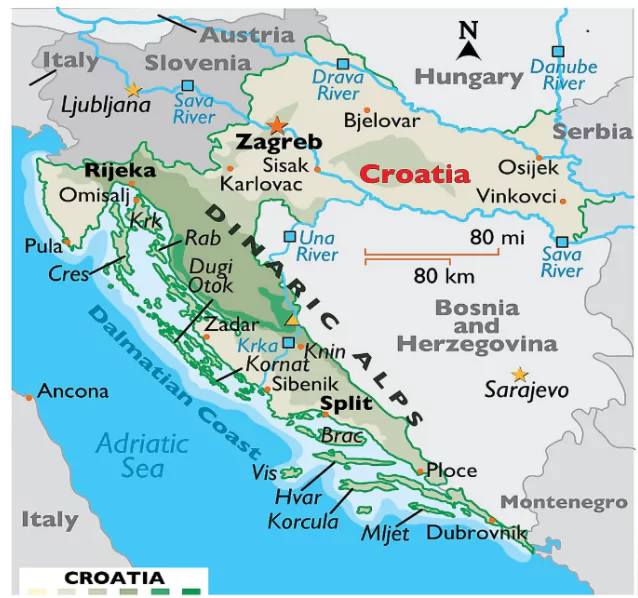Recently, the Indian Prime Minister paid a maiden visit to Croatia as part of the last leg of his three-nation tour, which included Cyprus and Canada.
- PM Modi expressed gratitude for Croatia’s support following the Pahalgam terror attack, highlighting shared democratic values and commitment to combatting terrorism.
Croatia

- Location: Situated in Southeastern Europe on the Balkan Peninsula.
- Bordering Nations: Hungary, Slovenia, Serbia, Bosnia and Herzegovina
- Geographical Features:
- Topography: Around half of Croatia is characterized by karst (limestone) terrain, especially prominent in the Dinaric Alps.
- Major Mountain Range: Dinaric Alps ( Dinara – Highest point)
- The country experiences both Mediterranean and continental climates.
Rivers
- Black Sea Basin: Danube, Sava, Drava, Mura, and Kupa
- Adriatic Sea Basin: Neretva, Cetina, Krka, and Zrmanja
|
Key Outcomes of Visit
- Defence Cooperation Plan: Building upon the 2023 Memorandum of Understanding on Defence Cooperation, both agreed to;
- Joint military training.
- Personnel exchanges.
- Industry-level defence partnerships.
- Extend cooperation in cybersecurity and defence production.
- Memorandums of Understanding (MoUs)
- Signed on Agriculture, Cultural Exchange, Science & Technology.
- Extension of the ICCR Chair of Hindi at the University of Zagreb till 2030
- Launch of joint academic research programs and a five-year cultural exchange initiative to deepen people-to-people ties..
- Investment and Economic Cooperation
- Commitment to enhance investments in key sectors: Pharmaceuticals, Agriculture, Information & Digital Technologies, Clean Technology, Semiconductors
- Croatia was invited to participate in India’s Sagarmala Project, tapping into its maritime expertise.
- Academic and Cultural Exchange
- Joint research projects between academic institutions.
- Finalisation of a five-year cultural exchange program to boost people-to-people ties.
- Space and Technology Collaboration: India announced plans to share its space technology expertise with Croatia, opening avenues for cooperation in satellite systems and space applications.
- Enhanced Mobility and Diplomatic Engagement
- Announcement of a forthcoming Mobility Agreement to facilitate travel, education, tourism, and business cooperation.
- Establishment of a framework for regular high-level diplomatic consultations, institutionalising the momentum generated by the visit.
Various Facet of India-Crotia Relations
- Economic:
-
- Bilateral trade has shown consistent growth, rising from $199.45 million in 2017 to $337.68 million in 2023.
- India exports: pharmaceuticals, chemicals, machinery, apparel, consumer goods.
- Croatia exports: chemicals, precision instruments, timber, rubber, vegetable fats and oils.
- Business ties supported by agreements such as the Bilateral Investment Protection Agreement (2001) and the India-Croatia Agreement on Economic Cooperation (2017).
- The India-Croatia Startup Bridge (2021) fosters collaboration in AI, robotics, and green tech.
- Cultural:
-
- Croatia has a strong tradition of Indology, with Sanskrit studies flourishing since the 18th century.
- Croatian scholar Ivan Filip Vezdin printed the first Sanskrit grammar book in 1790.
- The Indology Department at the University of Zagreb is a longstanding centre for Indian studies.
- Cultural heritage includes Croatian involvement in Indian architecture, like the Church of São Brás in Goa.
- The rising popularity of yoga and Ayurveda strengthens contemporary cultural connections.
- Diplomatic
-
- India recognised Croatia’s independence in May 1992, with formal diplomatic relations established in July 1992.
- Embassies opened in Zagreb (1995) and New Delhi (1996); relations were elevated to the ambassadorial level in 1998.
- Croatia has consistently supported India’s global positions, including UNSC permanent membership.
Significance of Croatia For India
- Geostrategic Gateway to Europe:
- Croatia’s position on the Eastern Adriatic coast makes it a key maritime gateway to the EU.
- Ports like Rijeka, Split, and Ploče are vital for the EU’s TEN-T transport network, offering direct access to Central and Eastern European markets.
- A critical link in the India-Middle East-Europe Economic Corridor (IMEC), especially amid disruptions in the Suez Canal and Red Sea.
- Croatia’s central position provides access to CEE markets.
- Useful in bypassing overdependence on traditional EU entry points like Germany or France.
- Strategic Alternative to Chinese Influence:
- Croatia’s limited participation in the Belt and Road Initiative (BRI) and cautious stance on China position it as a favourable partner for India.
- Strengthening India-Croatia ties contributes to New Delhi’s effort to provide a democratic, rule-based alternative to China’s growing footprint in the Balkans.
- Influence within EU and NATO : Croatia’s full membership in both the European Union and NATO offers India:
- Indirect access to EU regulatory and political processes.
- An ally within European consensus-building mechanisms, especially valuable during India-EU FTA negotiations.
- Reliable multilateral partner:
- Croatia consistently supports India’s international stances, including non-interventionist policies on Jammu & Kashmir.
- Offers reliability and predictability—a contrast to more complex postures of larger EU states.
![]() 20 Jun 2025
20 Jun 2025

